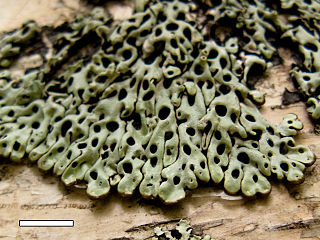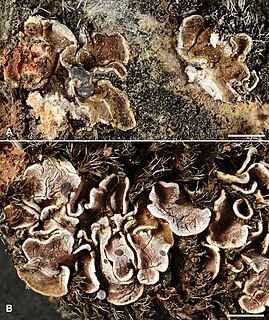
A lichen is a composite organism that arises from algae or cyanobacteria living among filaments of multiple fungi species in a mutualistic relationship. Lichens have properties different from those of their component organisms. They come in many colors, sizes, and forms and are sometimes plant-like, but are not plants. They may have tiny, leafless branches (fruticose); flat leaf-like structures (foliose); grow crust-like, adhering tightly to a surface (substrate) like a thick coat of paint (crustose); have a powder-like appearance (leprose); or other growth forms.

Acarospora is a genus of lichenized fungi in the family Acarosporaceae. Most species in the genus are crustose lichens that grow on rocks in open and arid places all over the world. They may look like a cobblestone road or cracked up old paint, and are commonly called cobblestone lichens or cracked lichens,. They usually grow on rock, but some grow on soil (terricolous) or on other lichens. Some species in the genus are fungi that live as parasites on other lichens. Acarospora is a widely distributed genus, with about 128 species according to a 2008 estimate.

Menegazzia is a genus of lichenized fungi containing roughly 70 accepted species. The group is sometimes referred to as the tree flutes, honeycombed lichens, or hole-punch lichens. The most obvious morphological feature of the genus is the distinctive perforations spread across the upper side of the thallus. This makes the group easy to recognise, even for those not particularly familiar with lichen identification.
Acarospora janae is a species of lichen in the Acarosporaceae family. Described as new to science in 2011, it is known only from New Mexico and Colorado in the United States, where it grows on siliceous rock.
Neobrownliella brownlieae is a species of saxicolous (rock-dwelling), crustose lichen in the family Teloschistaceae. It is widely distributed in Australia.

Crustose lichens are lichens that form a crust which strongly adheres to the substrate, making separation from the substrate impossible without destruction. The basic structure of crustose lichens consists of a cortex layer, an algal layer, and a medulla. The upper cortex layer is differentiated and is usually pigmented. The algal layer lies beneath the cortex. The medulla fastens the lichen to the substrate and is made up of fungal hyphae. The surface of crustose lichens is characterized by branching cracks that periodically close in response to climatic variations such as alternate wetting and drying regimes.

Acarospora socialis is a usually bright yellow aereolate to squamulose crustose lichen in the Acarosporaceae family that grows up to 10 cm wide, mostly on rock in western North America. It is among the most common lichens in the deserts of Arizona and southern California. It grows on sandstone, intrusive and extrusive igneous rock such as granitics, in all kinds of exposures to sunlight, including vertical rock walls. It is found in North America, including areas of the Mojave Desert and Sonoran Desert region, to Baja California Sur. It is the most common yellow member of its genus in southwestern North America. It sometimes, but rarely, grows on other soil crusts. It is a pioneer species.

Lecanora muralis(Protoparmeliopsis muralis) is a waxy looking, pale yellowish green crustose lichen that usually grows in rosettes radiating from a center (placodioid) filled with disc-like yellowish-tan fruiting bodies (apothecia). It grows all over the world. It is extremely variable in its characteristics as a single taxon, and may represent a complex of species. The fruiting body parts have rims of tissue similar to that of the main nonfruiting body (thallus), which is called being lecanorine. It is paler and greener than L. mellea, and more yellow than L. sierrae. In California, it may be the most common member of the Lecanora genus found growing on rocks (saxicolous).

Acarospora fuscata is a glossy pale or yellowish-brown areolate lichen with angular areolas that grows up to 10 cm (4 in) wide on non-calcareous rock in low and high elevations. It grows in Europe and North America. It grows in southern California and on the eastern part of the Sierra Nevada range. It may grow with the areolas disconnected. The areolas may lift at the edges, but the areolas do not overlap like true squamules (sub-squamulose). More common in the Sierras is the similar species Acarospora thamnina, which is truly squamulose with overlapping scales.

Acarospora thamnina is a shiny, black tinged, variously brown squamulose crustose lichen. It has a linear growth pattern, growing along cracks in boulders. It can be found in North America to Alaska and Maine, from the coast to inland locations, also in the Ural Mountains and Novaya Zemlya in Russia. It commonly grows either among, or on other lichens. It grows a longer stipe so its squamules can grow over other lichens when there is competition for space. When it forms thick clumps it is easily identified with its elevated squamules and thick stipes. It grows on acidic rock in full sunlight.

Punctelia hypoleucites, commonly known as the southwestern speckled shield lichen, is a species of foliose (leafy) lichen in the family Parmeliaceae. First formally described by Finnish botanist William Nylander as a species of Parmelia, it was transferred to the genus Punctelia in 1982. The lichen is found in Africa, North America, and South America, where it grows on the bark of both hardwood and coniferous trees. Its greenish-grey thallus is covered with tiny white pseudocyphellae – minute holes in the thallus surface that facilitate gas exchange. Some macroscopic features that help distinguish this species from other related members of the genus include the presence and the structure of the apothecia, the absence of asexual surface propagules, and the light brown color of the thallus undersurface. Chemically, the presence of lecanoric acid in the medulla and atranorin in the cortex help distinguish it from lookalikes.

Punctelia graminicola is a species of foliose (leafy) lichen in the family Parmeliaceae. It grows on rocks, and, less frequently, on bark in North America, South America, and East Africa. It has a blue-grey thallus measuring up to about 15 cm (6 in), covered with tiny pores called pseudocyphellae. Sometimes the lichen forms small lobes that project out from the surface. Fruiting bodies are uncommon in this species; if present, they resemble small cups with a brown internal disc measuring 3–10 mm (0.1–0.4 in) in diameter. A lookalike species, Punctelia hypoleucites, is not readily distinguishable from Punctelia graminicola by appearance or habitat alone; these species can only be reliably differentiated by examining the length of their conidia.

Silobia rufescens is a lichenized fungus, with a dark gray or brown crust-like appearance. It is widespread, and grows on siliceous rock. S. rufescens is in the genus Silobia, which is segregated from the genus Acarospora due to its budding apothecia with only lateral exciple.
Waynea cretica is a species of corticolous (bark-dwelling), squamulose lichen in the family Ramalinaceae. It occurs on the Greek island of Crete and in Portugal.
Variospora aegaea is a species of saxicolous (rock-dwelling), crustose lichen in the family Teloschistaceae. First identified from Greek islands in the Aegean Sea, and has since been recorded in Italy and Spain.
Acarospora pseudofuscata is a species of saxicolous (rock-dwelling) crustose lichen in the family Acarosporaceae. It occurs on a few islands in the Aegean Sea and in Turkey.
Lecanora panticapaensis is a species of saxicolous (rock-dwelling), crustose lichen in the family Lecanoraceae. It occurs in a single locality in Dnipropetrovsk Oblast, Ukraine, where it grows on the vertical surfaces of black schist beside a river.
Lecania sessilisoraliata is a species of saxicolous (rock-dwelling), crustose lichen in the family Ramalinaceae. It is found on rock outcrops in the mountainous Burdur region of Turkey.

Psora taurensis is a species of terricolous (ground-dwelling), squamulose lichen in the family Lecanoraceae. It is found in the Taurus Mountains of Turkey.

Solorina crocea, commonly known as the orange chocolate chip lichen, is a species of terricolous (ground-dwelling) and foliose (leafy) lichen in the family Peltigeraceae. The lichen, which was first formally described by Carl Linnaeus in 1753, has an arctic–alpine and circumpolar distribution and occurs in Asia, Europe, North America, and New Zealand. It generally grows on the bare ground in sandy soils, often in moist soil near snow patches or seepage areas. Although several forms and varieties of the lichen have been proposed in its history, these are not considered to have any independent taxonomic significance.












